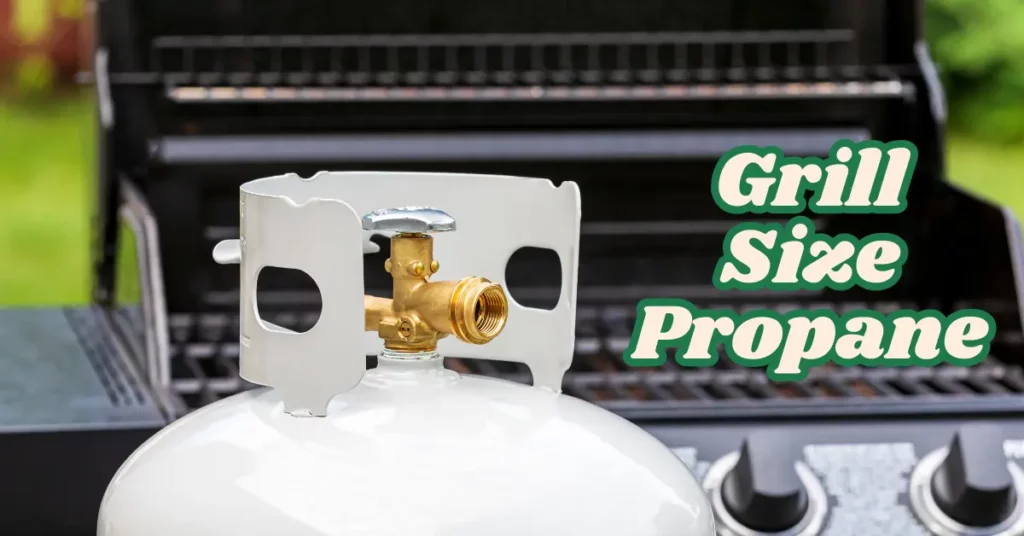This post may contain affiliate links. If you use these links to buy something we may earn a small commission. Thanks.
Grilling is more than just cooking; it’s an experience, a tradition, and for many, a way to bring family and friends together. To ensure you get the most out of your grilling adventures, selecting the right propane tank size is essential. Propane tanks power your grill, and choosing the correct size ensures a seamless cooking experience without interruptions. This guide will walk you through the common propane tank sizes, factors to consider, and how to maintain your tanks for long-lasting use.
Common Propane Tank Sizes for Grills
1-Pound Cylinder
The 1-pound cylinder is the smallest propane tank commonly used for grilling. These tanks are ideal for portable grills and camping trips where compactness and convenience are priorities. While they are lightweight and easy to transport, their cooking duration is limited, making them suitable only for small-scale grilling sessions.
You may Interested: How To Hook Up A Propane Tank To A House
5-Pound Tank
A step up from the 1-pound cylinder, the 5-pound tank provides slightly more cooking time while remaining portable. It’s a popular choice for tailgating or casual grilling sessions. These tanks are easy to handle and refill, offering a good balance for those who don’t grill frequently.
20-Pound Tank (Standard Grill Size)
The 20-pound tank is the most common size for backyard grills. It’s the standard for gas grills due to its compatibility and efficiency. A full 20-pound propane tank provides approximately 18-20 hours of cooking time, depending on your grill’s BTU output. This size is perfect for regular grilling sessions, offering a reliable balance of portability and capacity.

30- and 40-Pound Tanks
Though less common for household use, 30- and 40-pound tanks are excellent options for extended grilling sessions or high-output grills. They are particularly useful for enthusiasts who host frequent barbecues or cook large quantities of food. These tanks offer extended cooking times, reducing the need for frequent refills.
100-Pound Tank
The 100-pound tank is a powerhouse, typically reserved for heavy-duty grilling or dual-purpose setups, such as combining home heating with grilling. Due to its size and weight, it requires stationary placement and is not portable. This tank is ideal for commercial use or avid grillers who need a long-lasting propane supply.
Factors to Consider When Choosing a Tank Size
Frequency of Use
Your grilling habits play a significant role in determining the ideal propane tank size. If you grill occasionally, a smaller tank like a 5-pound or 20-pound might suffice. However, frequent or heavy grillers will benefit from larger tanks to avoid constant refills.
Type of Grill
The type of grill you own also affects your tank choice. Portable grills are compatible with smaller tanks, while larger backyard grills often require a standard 20-pound tank. High-performance grills with greater BTU output may need larger tanks for optimal performance.
Grill Output (BTUs)
BTU (British Thermal Unit) ratings indicate the energy output of your grill. Higher BTU grills consume propane faster, requiring larger tanks to sustain longer cooking sessions. Understanding your grill’s BTU rating helps estimate propane usage and ensures you select a suitable tank size.
Storage Space
Before purchasing a propane tank, consider where you’ll store it. Smaller tanks are easier to store and transport, making them ideal for limited spaces. Larger tanks require more storage room and should be kept in well-ventilated areas for safety.
Convenience
While larger tanks last longer, they can be heavy and cumbersome to move. If portability and ease of handling are priorities, smaller tanks are more convenient. However, larger tanks reduce the hassle of frequent refills, which might outweigh their lack of portability.
How to Calculate Propane Usage
Understanding your propane usage helps you plan and prevents mid-grill interruptions. Most propane tanks are rated by weight, with 20-pound tanks being the standard for grills. Here’s a simple formula to estimate propane consumption:
- Find your grill’s BTU rating (usually mentioned in the manual).
- Divide the BTU rating by the BTUs in a gallon of propane (approximately 91,500 BTUs per gallon).
- Multiply the result by the tank capacity in gallons.
For example, a 20-pound propane tank holds about 4.7 gallons. If your grill’s BTU rating is 40,000:
40,000 / 91,500 = 0.437 gallons per hour
4.7 gallons / 0.437 = ~10.75 hours of cooking time
This calculation provides a rough estimate to help you gauge how long your propane supply will last.
Advantages and Disadvantages of Different Sizes
Small Tanks
- Pros: Lightweight, portable, and easy to store. Ideal for occasional use or small grills.
- Cons: Limited cooking time and frequent refills required.
Medium Tanks
- Pros: A versatile option for most home users. Offers a good balance between portability and capacity.
- Cons: Heavier than small tanks but manageable.
Large Tanks
- Pros: Long-lasting and require fewer refills, making them ideal for frequent grilling.
- Cons: Heavy, less portable, and require ample storage space.
Maintenance and Safety Tips for Propane Tanks
To ensure safe and efficient grilling, proper maintenance of your propane tank is essential. Follow these tips:
- Inspect for Leaks: Check for leaks before each use by applying soapy water to the tank connections and looking for bubbles.
- Store Properly: Always store propane tanks upright in a well-ventilated area, away from heat or direct sunlight.
- Handle with Care: Avoid dropping or mishandling tanks to prevent damage.
- Check Expiration Dates: Propane tanks have expiration dates. Ensure your tank is within its usable timeframe to avoid safety hazards.
- Refill or Exchange: Regularly refill or exchange your tank to avoid running out of propane during grilling sessions.
Conclusion
Choosing the right propane tank size is a crucial step in ensuring a hassle-free grilling experience. From small 1-pound cylinders to robust 100-pound tanks, each size serves different needs and preferences. Assess your grilling habits, the type of grill you use, and your storage space to make an informed decision. With the right tank, you can enjoy uninterrupted grilling sessions and focus on creating delicious meals for your family and friends. Happy grilling.
